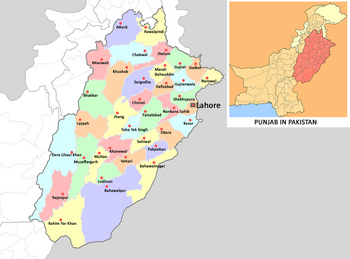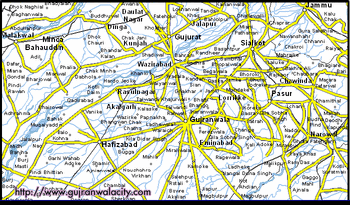Gujranwala


Gujranwala District (Urdu: ضلع گوجرانوالہ) is a district in Punjab province, Pakistan. The ancient village Asarur has been identified as the location of Taki, visited by the Chinese pilgrim Hiuen Tsiang about 630 AD and mentioned as capital of Punjab. [1]
Tahsils in the District
Jat clans in Gujranwala District
According to 1911 census, the following were the principal Muslim Jat clans in Gujranwala District [2]:
Aulakh (357), Bajwa (2,483), Bhangu (372), Buttar (842), Chahal (609), Chatha (2,804), Chhina (3,252), Cheema (21,735), Deo (108), Dhariwal (744), Dhillon (769), Dhotar (357), Ghumman (1,429), Gill (2,635), Goraya (3,591), Haral (643), Hanjra (4,334), Kahlon (261), Kharal (12,077), Khokhar (7,893), Lodike (2,675), Maan (463), Mangat (549), Randhawa (577), Sahi (1,050), Sarai (296), Sidhu (196), Sandhu (3,192), Sipra (658), Samra (406), Tarar (4,841), Virk (7,644) and, Waraich (9,510).
History
The village of Asarur has been identified as the location of Taki, an ancient town, visited by the Chinese pilgrim Hiuen Tsiang about 630 AD and mentioned as capital of Punjab. It contains immense ruins of Buddhist origin. After the time of Tsiang little is known about Gujranwala till the Islamic conquests, by this time however Taki had fallen into oblivion while Lahore had become the chief city of Punjab. [3]
The district flourished during Mughal rule, from the days of Akbar to those of Aurangzeb, wells were scattered over the whole country, and villages lay thickly dotted about the southern plateau, now a barren waste of grass land and scrub jungle. Their remains may still be found in the wildest and most solitary reaches of the Bar.
Visit by Xuanzang 633 AD
Alexander Cunningham[4] writes about Taki or Asarur:
[p.191]: I have already mentioned Asarur as the probable position of Hwen Thsang's Tse-kia (Taka), which was the capital of the Panjab in A.D. 633. It is situated about 2 miles to the south of the high-road between Lahor and Pindi Bhatiyan, being 45 miles from the former, and 24 from the latter place.1 It is 19 miles distant from Sangala by the road, but not more than 16 miles in a direct line across the country. Nothing whatever is known of its ancient history, but the people say that it was originally called Udamnagar, or Uda-Nagari, and that it was deserted for many centuries, until Akbar's time, when Ugar Shah, a Dogar, built the Masjid, which still exists, on the top of the mound. The antiquity claimed for the place is confirmed by the large size of the bricks, 18 by 10 by 3 inches, which are found all over the ruins, and by the great number of Indo-Scythian coins that are dis- covered annually after heavy rain. It therefore reaches back to the first century before the Christian era, and from its position I believe it to be the Pimprama of Alexander.
The ruins of Asarur consist of an extensive mound 15,600 feet, or nearly 3 miles in circuit. The highest point is in the north-west quarter, where the mound
1 See Map No. VI.
[p.192]: rises to 59 feet above the fields. This part, which I take to be the ancient palace, is 600 feet long and 400 feet broad, and quite regular in shape. It contains an old well 21 feet in diameter, which has not been used for many years, and is now dry. The palace is completely surrounded by a line of large mounds about 25 feet in height, and 8100 feet, or 1½ mile in circuit, which was evidently the stronghold or citadel of the place. The mounds are rounded and prominent, like the ruins of large towers or bastions. On the east and south sides of the citadel the mass of ruins sinks to 1 and 15 feet in height, but it is twice the size of the citadel, and is, no doubt, the remains of the old city. I could find no trace of any ancient buildings, as all the surface bricks have been long ago carried off to the neighbouring shrine of Ugar Shah at Khangah Masrur ; but amongst the old bricks forming the surrounding wall of the Masjid I found three moulded in different patterns, which could only have belonged to buildings of some importance. I found also a wedge-shaped brick 15 inches long and 3 inches thick, with a breadth of 10 inches at the narrow end, and nearly 10½ inches at the broad end. This could only have been made for a stupa, or a well, but most probably for the latter, as the existing well is 21 feet in diameter. Asarur is now a small village of only 45 houses.
Hwen Thsang places Tse-kia at 14 or 15 li, or 2½ miles, to the north-east of Sakala ; but as there are no traces of any former town in this position, I think it very probable that the true numbers should be 114 or 115 li, or 19 miles, which is just the distance between Sangala and Asarur by the road, although in a direct
[p.193]: line it is not more than 16miles. The circuit of Tse-kia was about 20 li, or upwards of three miles, which agrees sufficiently well with my measurement of the ruins of Asarur at 15,600 feet, or just three miles. At the time of Hwen Thsang's visit there were ten monasteries, but very few Buddhists, and the mass of the people worshipped the Brahmanical gods. To the north-east of the town at 10 li, or nearly 2 miles, there was a stupa of Asoka, 200 feet in height, which marked the spot where Buddha had halted, and which was said to contain a large quantity of his relics. This stupa may, I think, be identified with the little mound of Sālār, near Thata Syadon, just two miles to the north of Asarur.
Rise of Sikh Jat power
During the rise of Sikh Jat power, the waste plains of Gujranwala were seized by the military adventurers who then sprang up. Charat Singh, the grandfather of Maharaja Ranjit Singh of Lahore, took possession of the village of Gujranwala, then an inconsiderable hamlet, and made it the headquarters of himself and of his son and grandson. Minor Sikh chieftains settled at Wazirabad Sheikhupura, and other towns; while in the western portion of the District the Bhattis and Chatha-Jats maintained a sturdy independence. In the end, however, Ranjit Singh succeeded in bringing all the scattered portions of the District under his own power.[5]
The Maharaja himself was born at Gujranwala, and the town continued to be his capital up to his occupation of Lahore. The mausoleum of his father is still to be seen there, and a lofty cupola close by covers a portion of the ashes of Ranjit Singh himself. The Sikh rule, which brought prosperity elsewhere, also appears to have been an unmitigated benefit to Gujranwala. Ranjit Singh settled large colonies in the various villages, and was very successful in encouraging cultivation throughout the depopulated plain of the Bar. In the Degh valley, especially, he planted a body of hard-working Hindus, the Labanas, to whom he granted the land at a nominal rent.
According to the 1901 census the District had a population of 890,577 and contained 8 towns and 1,331 villages. Its population according to the 1881 census was 616,892 rising to 690,169 in 1891. The population increased by 29 per cent between 1891 and 1901 - the increase being greatest in the Hafizabad and Khangah Dogran tahsils, owing to the extension of canal-irrigation and the colonisation of the Bar.
Maan clan History
Mogalchak (Mughal Chak) is a village of Man Jats in district Gujranwala, Punjab Pakistan.
Mughal Chak was founded by Ladha Maan (लधा मान), who had gone from Lowa Kalan in Jhajjar district of Haryana. [6]
Sir Lepel H. Griffin [7] writes that Ladda Man, the founder of Mogalchak family of Mans migrated from Delhi to country near Gujranwala, founded a village Man and was made it head-man of 22 villages. Nikka Man, the 4th in descent from Ladda Man founded village Nikka, which passed to Mirza Kila, who destroyed it and built a new village and called it Mogalchak.
Notable persons
External links
References
- ↑ Gujrānwāla District Imperial Gazetteer of India, v. 12, p. 355
- ↑ Census Of India 1911 Volume xiv Punjab Part 2 by Pandit Narikishan Kaul
- ↑ Gujrānwāla District Imperial Gazetteer of India, v. 12, p. 355
- ↑ The Ancient Geography of India/Taki,pp.191-193
- ↑ Gujrānwāla District Imperial Gazetteer of India, v. 12, p. 355
- ↑ Jat History Dalip Singh Ahlawat/Chapter III, Page 303
- ↑ The Punjab Chiefs by Sir Lepel H. Griffin (1865)
Back to Pakistan

